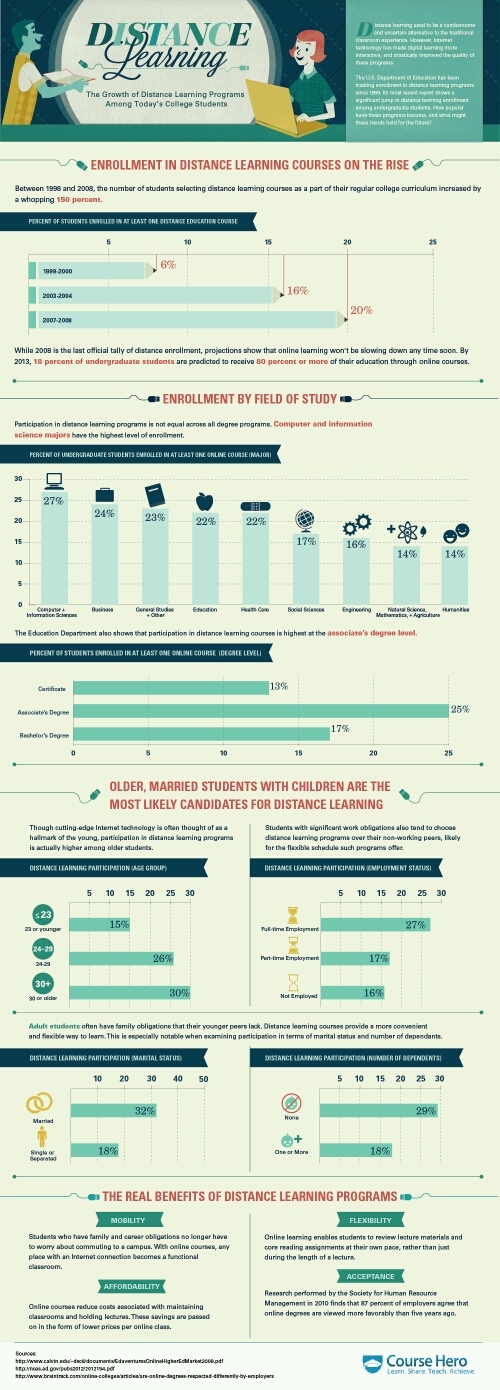http://www.coursehero.com/blog/2012/03/23/infographic-the-growth-of-distance-…
Posted on March 23, 2012 by Course Hero
For those whom the classroom model was too limiting, online learning has opened up new opportunities to pursue higher education. Distance learning has grown in popularity as the Internet and better technology have enabled increasingly dynamic and engaging learning experiences. Our latest infographic takes a look at the growth of distance learning over the last decade and examines which demographics have benefitted the most from online courseware. Check it out!
http://www.inc.com/michael-olguin/5-tips-for-managing-millennial-employees.html
Motivating the millennial generation is key to business success. Here are five tips to inspire and motivate the new working class.
Given that more than 60 percent of my staff is comprised of millennials, I feel abundantly qualified to share what I have learned over the last 20 years in business when it comes to motivating these unique individuals. Unlike Baby Boomers or Gen X employees, motivating millennials requires that you make them feel empowered but also involved in the decision-making process.
Before we get too far down the road, it’s important to clearly define the term millennial. By most definitions, millennials were born between 1982 and 1996. These individuals’ personalities were shaped by the personal technology era combined with parental guidance that was nurturing to a fault (i.e., an “everyone gets a trophy” mentality). These two influences created a sometimes confounding workforce that is at best difficult to understand and at worst entitled.
But don’t allow your lack of understanding millennials get the better of you. Instead, consider the following five tips, which will make managing them easier while engaging them more in your company, brand or department.
1. Reinforce the positives
Millennials need constant affirmation and positive reinforcement in order to feel like they are doing a good job. Thus, on a regular basis managers should tell their millennial staffers that they appreciated their input, liked their thinking or were effective in their execution. This will make them feel needed and valued.
2. Recognize that each person is different and must be managed differently
Like any group, not all millennials are the same. Therefore, it’s important to not implement a “one size fits all” approach to managing them. One millennial might like constant direction while another prefers to do it all by themselves. The rule of thumb is millennials want to believe that you understand them and are not going to try and “old school” them with the ways something used to be done when you were a young executive.
3. Be flexible
Millenials by nature don’t really like rules. They grew up in an environment where parents asked their opinions, allowed them to make decisions, and rarely pushed something on them that they didn’t like. As a result, current college recruits are not used to the rigidity of most workplaces. If you press too hard on them to comply with the company’s position on things like hours or attire, you could very easily find yourself losing a good employee.
4. Allow as much ownership as possible
The best way to handle a millennial’s feelings of entitlement is to provide them with a lot of responsibility. This doesn’t necessarily mean handing them an entire project, but clearly defining areas that they can own so they can flex their knowledge, expertise and decision-making ability. When doing so, you will find them embracing not only the work, but you as a manager and the company overall.
5. Don’t be vague
Millennials are not good at interpreting what you meant and rarely succeed when put into a situation to “wing it” themselves. Though they want responsibility and authority, they are uncomfortable without having some sort of framework for the task at hand. The best scenario is good instructions and a lot of flexibility in how you get there.
Though managing millennials can certainly be challenging—particularly for managers who have no experience in this area—it is not a lost cause and can yield many benefits as they are smart, creative, tech-savvy and resourceful workers. However, since they grew up in the “everyone gets a trophy” culture, you must be extremely sensitive to what makes them tick or you might find them moving back in with mom and dad, who still think they are too young to be committing to a career!
Read more:
7 Steps to Building Your Dream Team Epic Fail: 3 Ways to Come Back Stronger One Trait to Look for in Every Hire
Michael A. Olguin is the president of Formula PR, a national public relations boutique with offices in New York, Los Angeles and San Diego. With over 25 years of experience, he has represented such high-profile brands as Newcastle, Kashi, and ESPN. @FormulaPR

